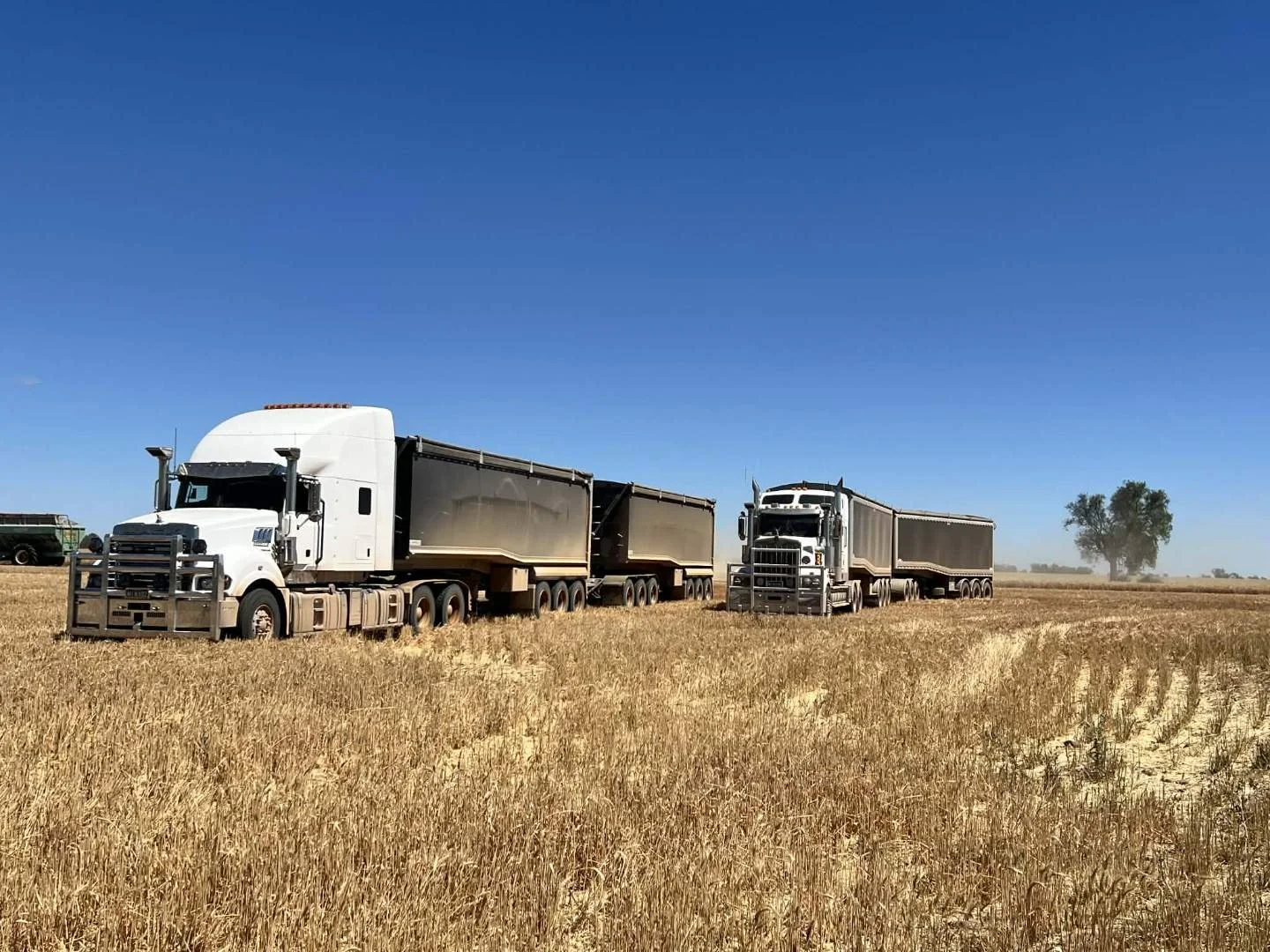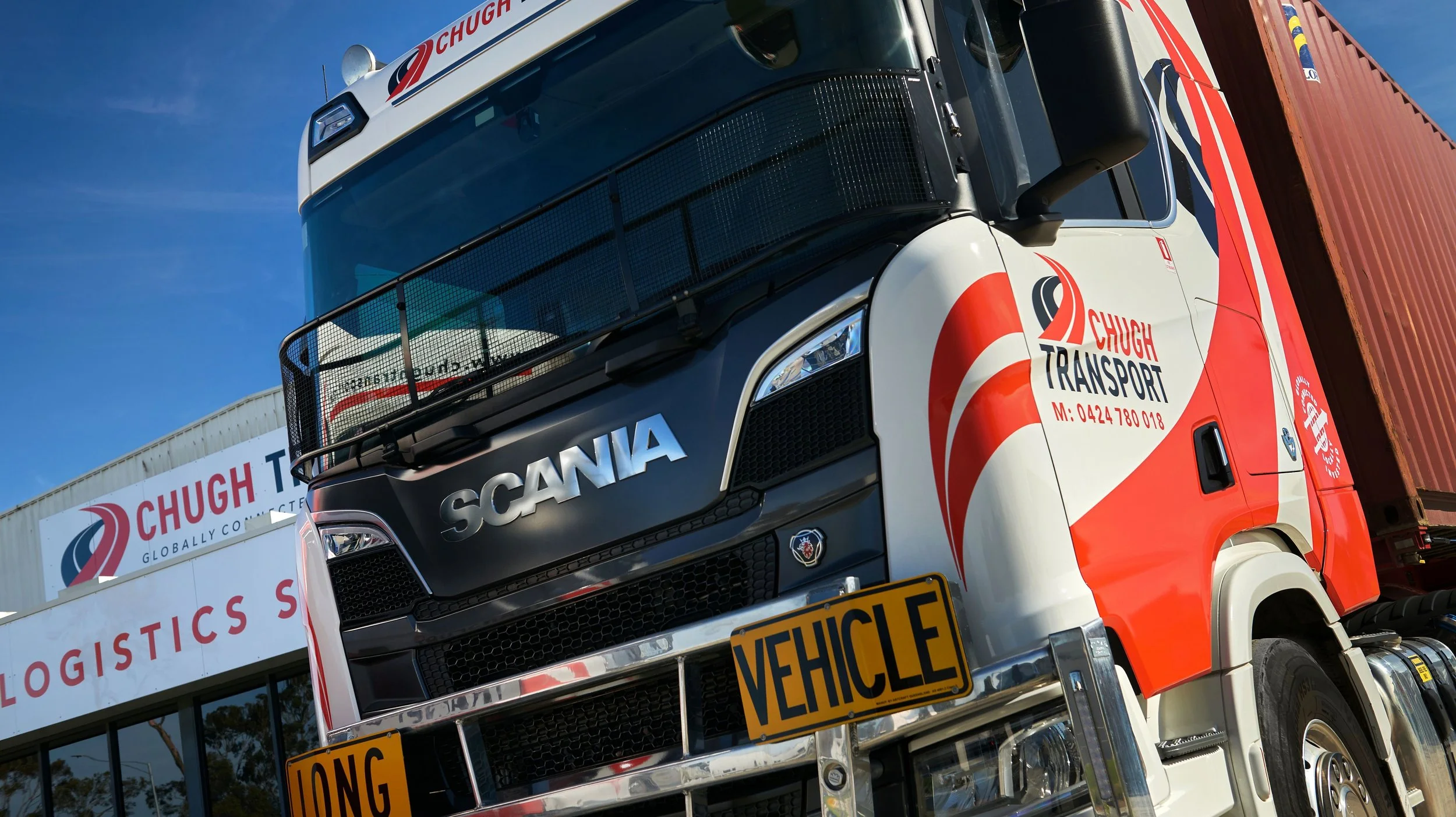Freightliner Cascadia’s 34 Pallet Solution
Forty metres! Backwards! In a dead straight line. In a B double! Another 30 metres or so and I’d have had my MC licence.
Unfortunately I wasn’t at DECCA, and after those 40 metres Darryl, my co-pilot announced that I had plenty of room to navigate the B double through the narrow exit. Then he attached the DUI plates to the truck. (Sad Face!) . . . . .
I’m in Horsham with Freightliner Southern Field Service Manager, Daryl Fourter to have a play with the latest iteration of the Cascadia, this particular one being the 126 version with the 36” bunk.Why not have a 60” one you may ask? Well that’s because Australia’s antiquated laws only allow 26 metres overall. So, if you wish to tow a B-double – in this case with a setup that will take 34 pallets – you want a bonneted truck, and of course a bullbar up front (and who wouldn’t in this land?), then this is what you’ll have to look at. Freightliner will happily sell you any bunk size you want but it will limit what you can hook on to the back.
Freightliner has come up with the perfect compromise. Let’s not forget that whilst we’d all like the most spacious prime mover our pockets will allow, it’s the cargo that makes the money. More cargo, more dosh. Simples. Until the current laws catch up with sensibility, compromise is mandatory.
Cab over’s will handle the 26 metres which is why we see so many of them on the road, and Daimler can accommodate you in this area with their excellent Actros, but for some, nothing will do unless it’s got a bonnet on it. It’s called freedom of choice, and it’s these folk to whom the 126/34 pallet Cascadia is aimed.
As mentioned, the bullbar is a necessary inclusion and there were a few internal doubts as to whether the combo would be possible, so Freightliner went to Krueger Trailers who said, “No problem.”
Cascadia has been in the States for many years - the land of massive wheel-based, blunt-nosed behemoths - where it is the best selling truck by a country mile. By comparison it is relatively new to Australia and was a dramatic change from its predecessor, the Coronado.
Freightliner admit that they lost a few customers with the changes but maintain that they picked up a heap more who’ve never had a Cascadia and in many cases not been with the Freightliner band at all. That they love the Cascadia is reflected in the high proportion of buyers who tip their toe in the water, buying one truck and then returning to buy more.
Why is it so? ‘FUEL ECONOMY,’ he shouts in capital letters. Work all you like on producing better engines that use less fuel – and Freightliner have done just that with their excellent 16 litre DD16 Detroit engine putting out 600Hp and 2800Nmm mated to an also excellent Detroit DT12, 12 speed AMT gearbox – but you’ve got to push all that metal through the air at 100kph, and a big blunt nose is going to drink fuel like a drunken sailor does rum.
The Cascadia runs parabolic springs on the steer axle and airbags on the drive. There’s a full suite of safety systems on board with Adaptive Cruise Control, Lane Departure Warning and all the other acronyms you can think of. Side Guard Assist which lets you ‘see’ down the left hand side of the truck is an option that is becoming more popular, especially with fleets.
Sitting in the background as another part of the safety pack is Active Brake Assist or ABA. The Cascadia’s radar is looking ahead all the time as is the camera, and if there is a potential collision the truck will warn the driver. If the driver doesn’t intervene by changing lanes or applying the brakes, the truck will continue to warn them and if nothing eventuates it will go into a partial brake mode followed by full autonomous emergency braking. The truck will be doing its best to prevent nasty outcomes.
No one can prevent an accident completely but it is all about mitigation. That’s why Freightliner use the term mitigation rather than prevention. The fact is it’s not a perfect science but it will do its best to mitigate an outcome that could otherwise be an absolute disaster. As well as Active Brake Assist there is also ABS sitting in the background.
The view over the sloping bonnet is excellent. As mentioned it’s to aid the aerodynamics but it is also fairly short so you can place the truck on the road very easily. You’re not going to lose sight of a car or even a small child under this bonnet.
Freightliner achieved this by splaying the chassis rails and dropping the engine down some 3 inches which comes with the side benefit of placing the ‘daily check’ items within easier reach.
The side mirrors, sitting on a single stalk aren’t big but they work as well as any others I’ve come across with great vision and the benefit of being able to see over them. You’ll see some Cascadia’s with additional mirrors halfway down the bonnet – a bit like British cars of the ‘50’s. They look a little strange but Freightliner tell me that those who’ve optioned them swear by them.
That 12 speed ‘box can change gears manually by flicking the column mounted stalk up or down. You may use it once or twice as I did at first, but the ‘effort’ soon becomes too much and it becomes apparent that it is best left to its own devices. There’s a three-stage engine brake that works a treat. Daryl tells me that the brake lights are required by ADR to come on when it is used – something I’d never thought of before.
Press the ‘check light function on the key fob and the all the trucks lights will flash until you deactivate the function. You have no excuse of not knowing of a failed light. Climbing up into the cab and I’m greeted with the latest dashboard, nicked straight out of the Cascadia’s European half-brother, the Mercedes Actros. The two digital screens, to me at least, look aesthetically much better than the dials in the faux wood panelling of the earlier model.
So I’ve navigated the exit gate from the Horsham Field Days with those 44 pallets and Daryl starts to relax as I head down the tarmac (I’ve been behind the wheel of a B double on many occasions but I forgot to mention that to him). The trip back to Melbourne is a mixture of B road and highway driving, so I get to experience the worst of Victorian roads along with the occasional smooth stretches of tarmac.
The Cascadia handles itself with aplomb, requiring minimal input to the steering to keep the truck on the straight and often narrow. I pride myself on not setting the lane departure warning off at all on the ride.
With some 60 tons of ballast on board the truck hauls up hills with ease and the engine brake pulls it up smoothly and quickly when required. I reckon the cab is a little noisier than the similarly powered Actros but is by no means invasive, and Freightliner’s Daryl and I can chat amiably on the trip without raised voices.
Where Freightliner have excelled is in NVH – particularly in the cabin. The old Argosy used to rattle around a bit, something Freightliner admit they can’t worm their way out of. The company spent a fortune in design to ensure that the Cascadia RH drive models would be world class in this area and they have succeeded. Daryl tells me of one he recently drove which had over 800,000km on the clock and was as tight as Lycra on an overweight pushbike rider.
But what is most important with this combination is that there’s space behind me for those 34 pallets and that’s money to the bottom line. And no NHVR lackey can relieve me of any of that extra profit for being over length. The 34” bunk will comfortably sleep any size truckie and is aided and abetted by plenty of storage in and around the cabin.
If you want a bonneted truck and wish to haul the maximum payload you should look into the Cascadia.
More Blog Posts You Will Love
More From In-depth
Got something to say? Say it here!
truckinwithkermie.com is for YOU and about YOU. We’d love to hear your stories. There are a number of ways to get in touch with us:
kermie@truckinwithkermie.com
(+61) 0418 139 415


















